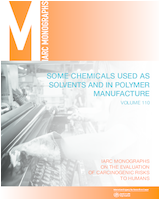NCBI Bookshelf. A service of the National Library of Medicine, National Institutes of Health.
IARC Working Group on the Evaluation of Carcinogenic Risks to Humans. Some Chemicals Used as Solvents and in Polymer Manufacture. Lyon (FR): International Agency for Research on Cancer; 2017. (IARC Monographs on the Evaluation of Carcinogenic Risks to Humans, No. 110.)
5.1. Exposure data
Tetrafluoroethylene is a fluorinated monomer that is produced by the pyrolysis of chlorodifluoromethane. Estimated annual world production of tetrafluoroethylene is more than 100 000 tonnes. It is used mainly as an intermediate in the production of the polymer polytetrafluoroethylene, which is used in a wide range of industrial and consumer products, e.g. non-stick coatings and waterproof clothing. The occupational setting is the main source of concern regarding exposure to tetrafluoroethylene, predominantly during its production and use in polymerization. Exposure levels have decreased (estimated from plants in the USA and in Europe at < 40 mg/m3 in the 1950s and 1960s, and now about < 6 mg/m3).
5.2. Human carcinogenicity data
Only one study evaluating the possible carcinogenic effect of tetrafluoroethylene has been reported. Moderately but not statistically significantly elevated standardized mortality ratios were observed for all sites of a-priori interest, i.e. cancers of the liver and kidney, and leukaemia, based on small numbers of cases. The study was well conducted in terms of completeness and follow-up of the cohort and exposure assessment, but study precision was low and the possible confounding from ammonium perfluorooctanoate could not be ruled out due to the high correlation between the two exposures.
5.3. Animal carcinogenicity data
There were two well-conducted studies of carcinogenicity with tetrafluoroethylene: one inhalation study in mice (males and females), and one inhalation study in rats (males and females). Tetrafluoroethylene increased the incidence of liver haemangioma and/or haemangiosarcoma, hepatocellular adenoma and/or carcinoma, and histiocytic sarcoma in male and female mice. In male and female rats, tetrafluoroethylene increased the incidence of renal cell adenoma or carcinoma (combined), and of hepatocellular adenoma and/or carcinoma. In female rats, tetrafluoroethylene caused an increase in the incidence of haemangiosarcoma of the liver. In rats, tetrafluoroethylene also caused increases in the incidence of mononuclear cell leukaemia in males and females, and testicular interstitial cell (Leydig cell) adenoma in males.
5.4. Mechanistic and other relevant data
Tetrafluoroethylene is a volatile, chemically unstable compound with poor solubility. Humans are primarily exposed through inhalation. Tissue distribution of tetrafluoroethylene is poorly characterized, but there is evidence for toxic effects at various tissues after exposure by inhalation. Urinary and faecal excretion of tetrafluoroethylene and its metabolites is likely, but elimination has not been studied in detail.
Unlike other halogenated compounds, tetrafluoroethylene is not metabolized by cytochrome P450 enzymes. Metabolism of tetrafluoroethylene is thought to primarily occur through the glutathione-conjugation pathway in the liver to the glutathione conjugate, which is further metabolized to the cysteine conjugate in the kidney. The resulting conjugate is an excellent substrate for cysteine conjugate β-lyase, which is known to form reactive electrophiles of cysteine conjugate metabolites of other halogenated compounds.
Limited data exist to characterize the potential genotoxicity of tetrafluoroethylene or its metabolites. No positive results were reported for either tetrafluoroethylene or its cysteine conjugate, but tests with kidney-derived metabolizing enzymes have not been performed.
Single, short-term, or long-term exposures to tetrafluoroethylene resulted in kidney toxicity in rats and mice. Both males and females were affected, although the effects in females occurred at a higher exposure level than in males. Liver enlargement and some evidence for liver toxicity have also been reported in studies with tetrafluoroethylene in rats and mice. Little is known about the mechanisms that may explain these adverse effects in the kidney and liver.
No study directly evaluated the potential role of genetic polymorphisms in the adverse health effects of tetrafluoroethylene. However, because of the major role that several glutathione S-transferase enzymes are likely to play in metabolism of tetrafluoroethylene, inter-individual variability in the formation of reactive electrophiles from the cysteine conjugate is plausible based on analogy to related chemicals. No studies were identified that explored whether lifestage susceptibility to tetrafluoroethylene exposure may exist.
Overall, the mechanistic data for tetrafluoroethylene are weak because the mechanistic events have not been directly established in humans or in experimental animals.
- Summary of Data Reported - Some Chemicals Used as Solvents and in Polymer Manufa...Summary of Data Reported - Some Chemicals Used as Solvents and in Polymer Manufacture
- Mechanistic and Other Relevant Data - Some Chemicals Used as Solvents and in Pol...Mechanistic and Other Relevant Data - Some Chemicals Used as Solvents and in Polymer Manufacture
Your browsing activity is empty.
Activity recording is turned off.
See more...
